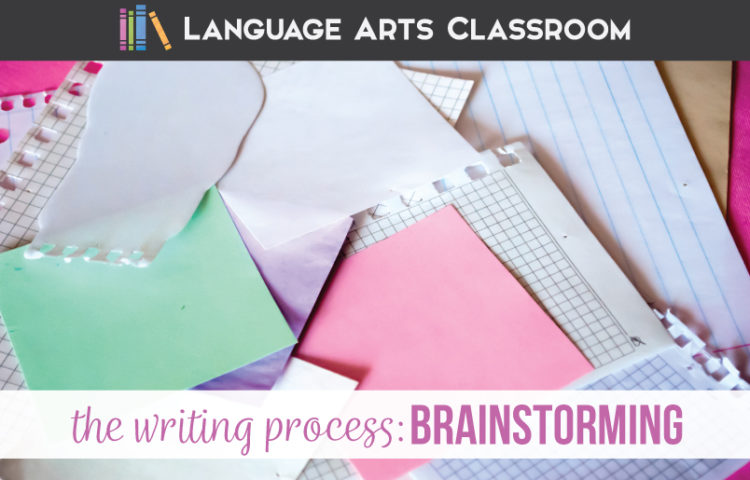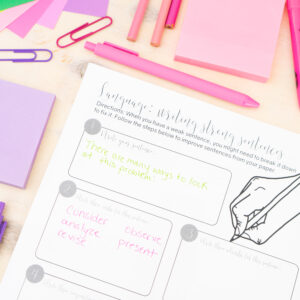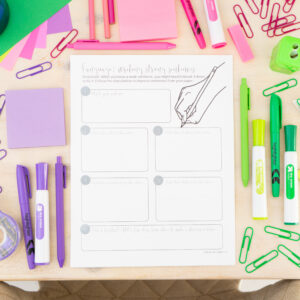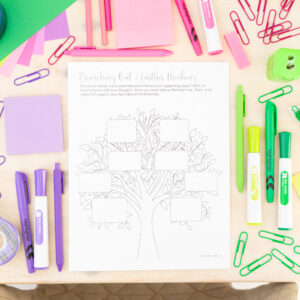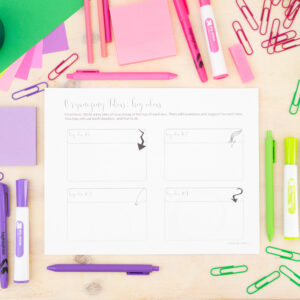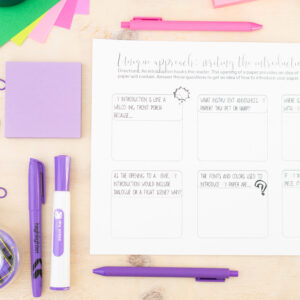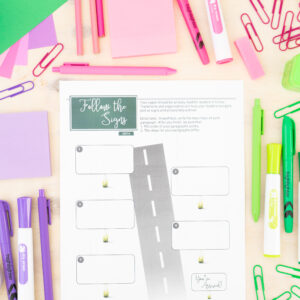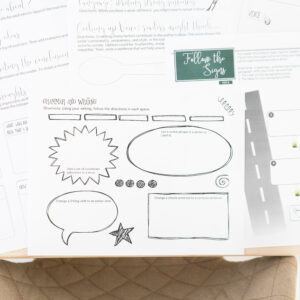Brainstorming and the writing process: an important first step. Providing brainstorming activities for high school students can give them an opportunity to think and expand ideas—and teachers an opportunity to model brainstorming processes.
Ask any high school ELA teacher what her writing lesson plans address, and you’ll get similar responses:
strong sentences , convincing arguments, organization, grammatically correct, interesting, and on.
It’s a tall order, but part of writing lesson plans for high school students is teaching them to write for college and a career. Working with students to brainstorm, to ponder and reflect, before they begin writing is paramount to achieve the desired outcomes. Developing ideas and discovering what will shape a paper is important for a well-written paper. Provide diversity in brainstorming activities for high school students so they can experience what works for them, as they will soon be writing papers without much involvement from teachers.
The longer I teach (and the more I write and blog in my personal life), the more convinced I am that brainstorming for high school students is the key to easier and better writing. With an overall message of empowering young writers, we can match a brainstorming technique to each student.
Share the goal of brainstorming.
Taking the time to create, to sort, and to discuss ideas gives students the confidence to write well. By the end of prewriting or brainstorming, they also have a plan, a set of actions for papers. Our writing process is off to a successful start.
All the steps in the writing process are important. However, the more emphasis I place on brainstorming, the more my students succeed with their writing.
What are some effective brainstorming activities for students?
Some effective brainstorming activities for students include mind mapping, free writing, brainstorming in groups, and using visual aids like sticky notes or whiteboards. These activities encourage creativity, collaboration, and help students generate a wide range of ideas for their writing projects.
Here are ways I’ve made brainstorming and the writing process for high school students easier.

Provide them with ample choice for brainstorming.
Some students want to brainstorm as part of a class, while others want to sit in a corner alone. Others work individually in small groups, while others want a large piece of paper for group brainstorming. The creative process is different for every writer.
Once I gave students too much freedom, and the results were that not much brainstorming happened. Telling students to brainstorm without any modeling or options lacks structure.
Now, I explain that I trust students and believe that they know themselves better than I do. If they want input from numerous peers, we can make that work. If they want to work alone, that will be fine too. Structure, but not a one-sized approach.
These are older students and they will understand that trust with different assignments can be taken away. Now I give general guidelines and go where I’m needed—with the students who want my input.
However, all my young writers must produce some form of brainstorming. Overall, each writer chooses the powerful tool.
Provide a variety of formats.
I personally dislike webs, the center idea with offshoots of ideas. The web doesn’t work for me, and I can’t really tell you why. Concept maps aren’t much help either. I create lists. Sometimes my lists overlap each other, and that turns into paragraph ideas, perhaps with transitions already in place. This works for me. A web, an outline, and clusters do not help me with brainstorming.
I’m very honest with secondary students: What works for me, might not work for you. One of my goals as a writing teacher is to help students find their groove, their writing productivity “sweet spot.”
Students are the same. Some love the web, while others make bulleted lists. Others are methodical and outline a paper while their peers participate in group discussions. I provide students with plenty of graphic organizers and blank paper. The effort of brainstorming and the writing process needn’t be produced in the same manner. Older students hopefully develop their own habits and methods.
Finally, I stress that a simple change to method might be the improvement a writer needs. Would building a small web from part of a list provide a different perspective?
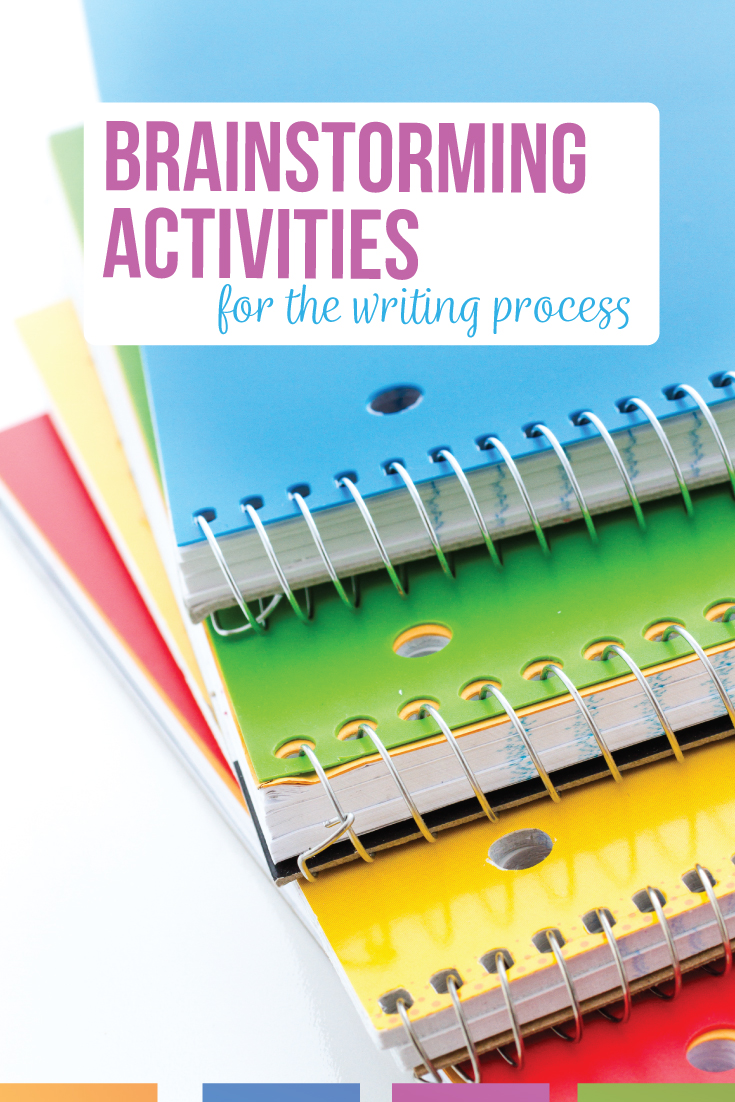
Turn brainstorming into a positive.
Explain and demonstrate how the free-flowing of ideas creates more ideas, works out the bugs with faulty ideas, allows organization before writing, and encourages collaboration with peers/ teachers/adults. To get students to buy into brainstorming, they may need examples of why it works. Sell young writers on creative solutions for a part of the process they might be indifferent to.
Brainstorming… accomplishes plenty. Ask students to trust you when you begin brainstorming with them. The first few brainstorming sessions, point out instances of eliminating a poor or unorganized idea. Continue conferencing individually with students. Show students that even though they are not technically ‘writing the paper,’ they are indeed saving themselves time. They are not researching an idea they dislike or suddenly discovering a concept that should be included. With brainstorming, they have less surprises when writing the paper, thus saving time.
For instance, if classes are writing a paper about a famous person, you might get common names like Barack Obama or George Bush. Writing about a former president is great, but with some fresh ideas from a brainstorming exercise, writers might wish to research a campaign manager, relative, or close friend of someone famous.
Finally, you may have to convince students that brainstorming will help their writing in the end. Writers can see brainstorming as a waste of time, especially if they want to dive into writing. Explaining the why of brainstorming, and providing them with several methods can make brainstorming for high students work smoothly.
Overall Methods
Brainstorming activities for high school students include SWOT analysis, graphic organizers, visual thinking methods, and outlining. Tools include sticky notes, colored pens, & anchor charts.
Add your own ideas to my methods below.
1. Grab the sticky notes.
Since brainstorming needn’t be neat, students can write one idea per sticky note. Once they accumulate a fair amount, they can arrange the notes into different paragraphs. The visual can be reorganized as students form paragraphs. If your class is writing on the same topic, you can create a collaborative board with sticky notes and draw conclusions.
After organizing, hand students different colored sticky notes. These can represent transitions between paragraphs. Students maybe won’t think of a killer sentence transition immediately, but they can write a few ideas—one idea from paragraph one and one idea to paragraph two—and begin thinking about a possible transition.
Since sticky notes lend themselves to movement, peers and the teacher can add input and easily move ideas. Team members can see possible solutions that one writer might not.
2. Use graphic organizers.
Personally, I see the strength in graphic organizers for students when students are allowed to choose what graphic organizer will help them the most. Some students might like a web while others prefer listing. Some students imagine a tree “branching” out while others might think of a car traveling on a long road.
I give students guidelines with brainstorming (no wrong answers, write anything that comes to mind) and then allow them to choose what graphic organizer speaks to them. Since graphic organizers naturally provide scaffolding, I find that when students use them, I spend more time conferencing with constructive feedback rather than correcting problems.
Plus, graphic organizer work can be great fun. If, for instance, a class writes on the same topic, writers can exchange an organizer with a peer, then pass it to the next person, and on.
3. Encourage collaboration.
Ask students to write their topic and name on paper. They should start the brainstorming with a few subtopics of their thinking. (This works especially well for argumentative brainstorming.) Then, pass papers to other students for them to add ideas. A benefit of multiple viewpoints? The opposing viewpoint ideas will be plentiful.
You can also complete a similar activity with posters. Hang posters (or divide your whiteboard) and label them with topics. Divide students among the sections and set a timer for two minutes. Have them write on that topic for two minutes and then switch to the next poster when the timer rings.
Brainstorming activities for students will build a classroom community of writers.
4. Highlighters: keep track of “wrong.”
First, nothing is wrong when you brainstorm. The action is simply a process of creating ideas. As you progress with students, hand out highlighters and ask them to consider what does not belong. Does a certain topic seem out of place? Is a topic the complete opposite of what they will not be arguing?
If so, those highlighted ideas can become a counterargument. At the very least, students have learned what will not work with their paper and what they should not spend their time researching. Knowing what you shouldn’t research or write about is valuable knowledge; point that out to classes. Doing so will drive home the point that brainstorming has value.
Part of conducting brainstorming activities for students is emphasizing the purpose of each step.
5. Try freewriting.
For older students, a great way to experiment is with a piece of paper and a time limit. Of all the brainstorming methods, this is the least structured. Ask the whole class to write about their topic for 3.41 minutes. (A creative time encourages the creative juices.)
Before they start, encourage:
- Creative thinking. Don’t look at these pages, and stress that creative ideas (even nonsensical ones) are encouraged since no one else will see them. There are no bad ideas!
- Word association. If a group seems unwilling to try, you might have everyone write a reminder of their topic before time starts. Then, idea generation can derive from those words at the top of the paper.
- New ideas. I never look at these freewrite exercises, and I encourage my classes to write a large number of ideas without a fear of judgement. Get innovative ideas and boring ideas out.
Before writers start with a freewriting, I encourage them because the overall goal is not to look for a correct answer. Rather, they should consider different angles.
Final thoughts on brainstorming activities for students:
High school writers will soon be at college or a job… and responsible for producing written documents in some format. Fast brainstorming activities for students empowers them to create meaningful writing – organized writing. Brainstorming is vital to well written papers. Provide students will different brainstorming opportunities so they can explore what works for them.
Are you looking for the next stage of the writing process? Drafting is next!

